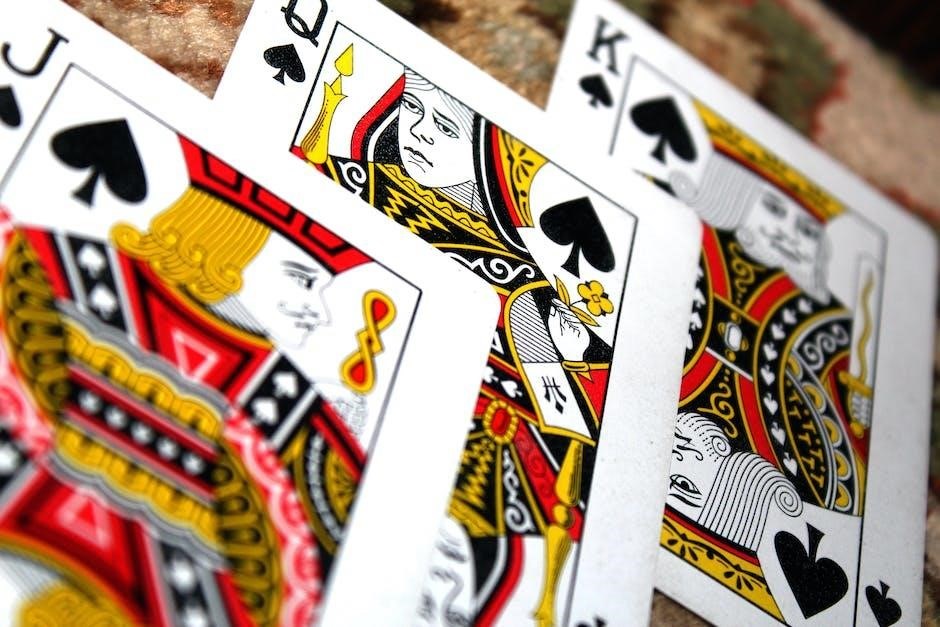The game of bridge is a refinement of whist‚ played by four people in two pairs‚ with a standard deck of 52 cards‚ and involves bidding and strategy to win tricks and score points effectively always online.
Historical Background
The game of bridge has a rich and fascinating history‚ with its origins dating back to the early 20th century. It is believed to have evolved from the older card game of whist‚ which was popular in England in the 18th and 19th centuries. The modern game of bridge emerged in the 1920s and 1930s‚ with the development of new rules and scoring systems. The game gained popularity in the United States and Europe‚ and by the mid-20th century‚ it had become a popular social activity among the upper classes. The game has continued to evolve over the years‚ with new variations and conventions being introduced. Today‚ bridge is played by millions of people around the world‚ both socially and competitively. The game has a unique culture and community‚ with its own terminology‚ etiquette‚ and traditions. The history of bridge is a testament to the power of social games to bring people together and create lasting communities. The game’s evolution is still ongoing‚ with new players and innovations being introduced all the time‚ shaping the game into what it is today.

Objective of the Game
The objective is to score points by winning tricks and fulfilling contracts‚ using strategy and skill to outmaneuver opponents effectively always online every time playing bridge games.
Basic Scoring
Scoring in bridge is based on the number of tricks won by a team‚ with points awarded for making contracts and penalties for failing to do so. The scoring system is designed to reward teams for taking risks and making contracts‚ while also penalizing them for overbidding or failing to fulfill their contracts. The basic scoring units are points‚ with different point values assigned to different types of contracts. Teams earn points for making contracts‚ with the number of points depending on the level of the contract and the type of contract. There are also bonuses for making game contracts‚ which are contracts that score 100 or more points. The team with the most points at the end of the game wins‚ with the goal of scoring as many points as possible by making contracts and fulfilling them. Scoring is a critical aspect of the game‚ as it determines the winner and the overall strategy of the teams.

Gameplay Basics
Bridge gameplay involves dealing cards‚ bidding‚ and playing tricks with partners sitting across the table from each other in a strategic card game always.
Player Roles
In the game of bridge‚ players have specific roles to fulfill‚ with each player having a unique responsibility to contribute to the team’s success. The declarer is the player who makes the final bid‚ and their partner is the dummy. The declarer’s role is to play the hand‚ while the dummy’s role is to lay down their cards and allow the declarer to play them. The other two players are the opponents‚ who try to defeat the declarer and their partner. Each player must work together with their partner to achieve their goals‚ using strategy and communication to outmaneuver their opponents. The player roles are crucial to the game‚ as they require teamwork‚ strategy‚ and effective communication to win. The players must also be able to adapt to different situations and make adjustments as needed to succeed in the game. Effective player roles are essential to winning at bridge.

Card Deck
The standard bridge deck consists of 52 cards in four suits‚ including clubs‚ diamonds‚ hearts‚ and spades‚ with each suit having 13 cards‚ totaling 52 cards always used.
Declarer’s Role
The declarer plays a crucial role in the game‚ as they are responsible for making strategic decisions to win tricks and score points. The declarer’s role is to lead the play‚ making the first move and setting the tone for the rest of the game. They must carefully consider their bids and plan their strategy accordingly‚ taking into account the strengths and weaknesses of their hand. The declarer’s goal is to take as many tricks as possible‚ while also trying to minimize the number of tricks taken by their opponents. To achieve this‚ they must use their skills and knowledge of the game to outmaneuver their opponents and make the most of their hand. Effective communication with their partner is also essential‚ as they must work together to achieve their goals. By playing strategically and making smart decisions‚ the declarer can help their team win the game and score valuable points. The declarer’s role requires a combination of skill‚ strategy‚ and teamwork.

Bidding and Overcalls
Bidding involves making strategic bids to communicate with partner and compete with opponents effectively always online using standard methods and conventions quickly.
Strategic Play
Strategic play in bridge involves making informed decisions to maximize the chances of winning tricks and achieving the desired contract. This requires a deep understanding of the game‚ including the rules‚ scoring‚ and tactics. Players must be able to analyze their hand‚ consider the bidding‚ and plan their play accordingly. Effective strategic play involves a combination of short-term and long-term thinking‚ as players need to balance the need to win immediate tricks with the need to set up future opportunities. By using techniques such as finessing‚ couping‚ and ducking‚ players can outmaneuver their opponents and gain an advantage. Strategic play also involves adapting to changing circumstances‚ such as the opponent’s bidding and play‚ and being able to adjust plans accordingly. Overall‚ strategic play is a critical component of successful bridge play‚ and requires a high degree of skill‚ experience‚ and attention to detail. Players must be able to think critically and make sound judgments quickly.
